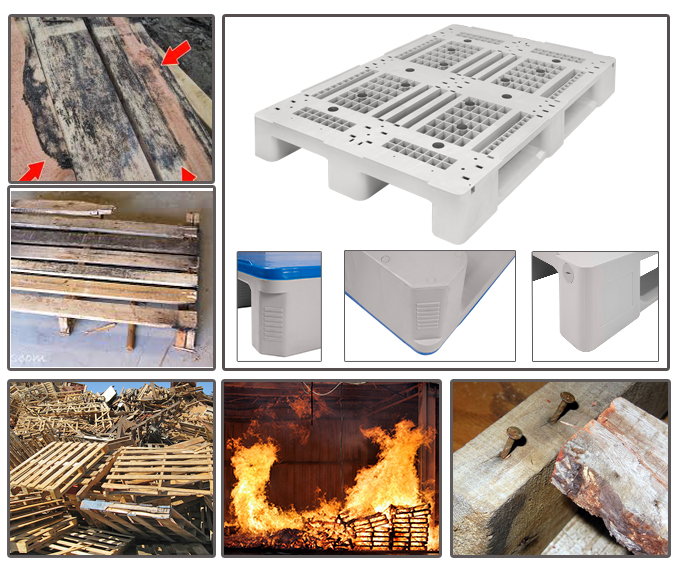Plastic vs. Wooden Pallets? Let’s start by the definition of the pallet which is a horizontal flat platform used as a base for carrying or stacking goods in unit load versus the loose moving/stacking of goods. It is typically a form of tertiary packaging in the supply chain. There are different kinds of pallets, depending on their dimensions, manufacturing material, entry points, decking, etc.
However, which one is the best is a hard question to answer it ultimately. Mostly, suppliers try to convince their prospects what they manufactured is the perfect choice to purchase.
Here we try to study the pallet in terms of material; Plastic Pallets vs. Wooden Pallets. Although IranPlast Group is the manufacturer of Plastic pallets here we tried to compare these two types of pallets excluding our conflict of interest. We are pointing out the similarities and differences, of both types and then summarizing the advantages and disadvantages of both types.
Plastic Pallets and Wooden Pallets Similarities
Both types of pallets meet the requirements of simplifying loading, unloading, and efficient storage. They ensure delivery of a considerable number of goods from point A to point B and piling of the products in a stabilized manner. Both can load light and heavy products and use them for flooring the warehouse and area. Furthermore, both types are compatible with fork-lift and hand jacks. Also, both have the potential to comply with ISPM 15, and both are repairable to some extent. Plastic and wooden pallets negatively impact the environment; one because of using plastic material, the other because of using natural resources.

Plastic Pallets and Wooden Pallets Differences

We face many different aspects when it comes to differences between plastic pallets and wooden pallets. Here we are trying to summarize the most significant differences between these two types; Plastic Pallet vs. Wooden Pallets.
Sanitizing and cleaning
We can easily and quickly clean plastic pallets. They can be hot washed, steam cleaned, or chemically sterilized. This makes the plastic pallets perfectly suitable for hygienically sensitive areas and products. However, wooden pallet cleaning requires a long and detailed procedure due to the nature of wood, especially if the wooden pallets are infected by fungus, bacteria, parasites, pests, and moths.
Pallet life-span
Plastic pallets are durable and have a particularly long “service life.” We can use plastic pallets for more than ten years if the pallets are treated correctly. The circulation rate of plastic pallets in a supply chain is considerably more than wooden pallets. Wooden pallets’ life span is around three to five years and needs to be replaced on repeated trips.
Dimensional stability
Plastic pallets keep their precise dimensions in different conditions, simplifying loading using pick-up gadgets and tools such as a forklift. In other words, plastic pallets are weather resistant. Wooden pallets’ sizes and weight vary in different areas and in contact with moisture or water, which might occur false alarms or errors in automatic conveyor systems.
Weight preciseness
The weight of the plastic pallet is stable and does not change during its trips since it obeys the material’s nature. However, the exact weight of wooden pallets varies from ear to area due to the condition since the wooden pallet can absorb water and humidity.
Customization
Plastic Pallets are made of high-density polyethylene in the procedure of injecting it into the metal mold designed and made before. Any modification which has not been seen and forecasted in the mold is costly and time-consuming. However, as the wooden pallets are made of boards and rafters, specific configurations are feasible.
Recycling option
Plastic pallets are recycled and can be reused as completely new plastic products. Usually, plastic pallet manufacturers collect old and useless plastic pallets from their customers and resources again to achieve maximum efficiency. Although wooden pallets can be recycled as well, the procedure is different, more complicated, and even expensive. The recycled wood will degrade and usually cannot re-produce new wooden rafters and boards suitable for wooden pallets.
Food Grade option
Although both plastic and wooden pallets can be food-grade. However, food-grade wooden pallets still are not the absolute option when contacting hygienic material. Moisturized wood has a high potential for spoiling or bacteria and fungi growth, especially if the wooden pallet remains wet for a long time. On the other hand, the integrated structure of plastic pallets is not a good host for foodborne pathogens and does not allow bacteria penetration into the pallet.
Pallet cost
Generally, plastic pallets are more expensive than wooden pallets. The former pallets are unlikely to be economical, especially if they are for export purposes, i.e., non-returnable pallets. However, as wooden pallets are heavier than plastic pallets, the shipping cost of wooden pallets will be higher if the calculation of the transportation is based on the weight.
Exports
Many exporters are obliged to export their goods in a palletized manner to create competitive privilege among their competitors, keep their products safe during the journey, or follow the destination rules. There is a low chance of recollecting the pallets after delivery; hence, the lighter and cheaper pallets are used, the more profit the exporter makes. The wooden pallet is a good choice unless the destination country or customers require a restriction and prohibition. However, the pallets are probably reused for multiple trips; using the plastic pallet is recommended due to their durability and long lifespan.
Pallet regulations
Plastic pallets meet safety and hygienic requirements and conform to most national and international regulations. However, wooden pallets must meet special needs and comply with pallet regulations when they want to use in different countries or for different products. For example, using wooden pallets in Australia demands conforming to ISPM-15 or packaging regulations (recycling). Some countries assign very restricted rules and forbid the importing or using wooden pallets in their territories.
Repairing
Although both plastic and wooden pallets can be repaired, wooden pallets are easier to repair if some parts are broken or damaged during use. However, the rate of repairing wooden pallets is higher due to low shock and hit resistance. Plastic pallet repairing demands special plastic welding tools to heal the broken part so the plastic pallet can return to the circle, while due to the plastic pallet’s high strength, the breaking percentage is less than the latter one.
Traceability option
In modern supply chains, warehouse management needs to trace the pallets of products in running the day-to-day operations. The trip of returnable pallets demands to be monitored. Each exit and arrival of the goods need to be registered in the integrated business process system. Some customers need the RFID tag or barcodes for the goods, and plastic pallets can answer such requirements. The wooden pallets do not such the capabilities to attach barcode stickers or insert RFID tags in the pallet.
Safety concerns
Despite wooden pallets, plastic pallets have smooth surfaces without splinters and nails. The rate of users’ injuries while using plastic pallets is almost zero compared with wooden pallets.
Wood nature is flammable, and when compared to plastic, any wooden product can ignite significantly sooner and quicker than plastic. This hinders the safety of wooden pallets in storage or warm places in touch with flammable material. The plastic pallet has a higher ignition point, and by adding an anti-flaming additive, the burning and firing can be controlled completely. In contact with fire, the pallet starts to be welded instead of firing like a candle.
Nails, fasteners, splinters, and the non-smooth surface of wooden pallets hinder the safety of loaded fragile items and could cause damage.
Furthermore, the shrinkage machines work better with plastic pallets in wrapping the goods on the pallets rather than wooden pallets due to splinters and nails.
Hygienic concerns
The contaminant-free structure of plastic pallets is water-proof and anti- absorbent to humidity, bacteria, and fungus. Plastic pallets are resistant to corrosion, rust, chemical material, and odorless, making the plastic pallet an ideal choice for industries with hygienic concerns and sanitation requirements. On the other hand, wooden pallets have the potential to rot and absorb moisture, infestation, odor, bacteria, and fungus.
Environmental impact
As mentioned in the first part of this article, both types of plastic and wooden pallets negatively impact the environment and can not be an absolute solution for Green Supply Chain Management. From environmental sustainability outlook, both types have a considerable impact on the environment. on the one hand, plastic pallets can be recycled many times and returned to circulation, while plastic material is not eco-friendly. On the other hand, the wooden pallet is made of wood means it comes from a sustainable natural resource, while to produce a plastic pallet, we need to cut a tree.
Carbon footprint
There is no certain conclusion which type has the negative carbon footprint, i.e., greenhouse gas emissions. On the one hand, the production of wooden pallets and incineration have a lower impact on the environment than the production and disposal of plastic pallets. On the other hand, plastic pallets compensate for this negative impact associated with their long lifespan rather than wooden pallets.
There is no certain conclusion which type has the negative carbon footprint, i.e., greenhouse gas emissions. On the one hand, the production of wooden pallets and incineration have a lower impact on the environment than the production and disposal of plastic pallets. On the other hand, plastic pallets compensate for this negative impact associated with their long lifespan rather than wooden pallets.
Plastic vs. Wooden Pallets advantages/disadvantages
Below is the summarized table for the advantages and disadvantages of plastic pallets and wooden pallets. Some important criteria in choosing the correct type of pallets are taken into consideration and tried to score them considering applications, users’ requirements, and demands.
| CRITERIA | Plastic Pallets | Wooden Pallets |
| Sanitizing | HIGH | LOW |
| Lifespan | HIGH | LOW |
| Precise dimension | HIGH | LOW |
| Precise weight | HIGH | LOW |
| Customization | HIGH | HIGH |
| Recycling | HIGH | LOW |
| Food contact | HIGH | LOW |
| Cost | HIGH | LOW |
| Export | MEDIUM | LOW |
| Regulations | LOW | HIGH |
| Repairing rate | LOW | HIGH |
| Repairing possibility | LOW | HIGH |
| Traceability | HIGH | LOW |
| Safety | HIGH | LOW |
| Hygiene | HIGH | LOW |
| Environmental impact | MEDIUM | MEDIUM |
| Carbon footprint | MEDIUM | MEDIUM |
Plastic Pallet vs. Wooden Pallet
Conclusion
Manufacturers, distributors, and logistics companies need pallets as an essential supply chain factor. The answer to the question about plastic pallets vs. wooden pallets is not easy; however, choosing the right pallet depends on the users’ concerns, needs, and demands. The fact is that each type of pallet has its pros and cons.


